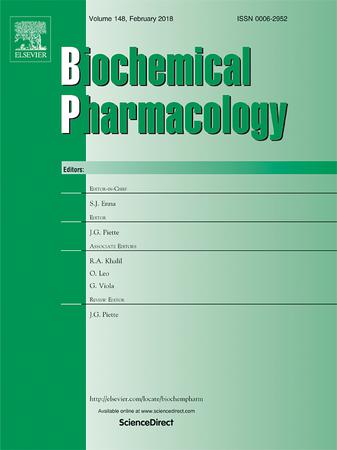ido1介导的AhR激活通过NRF2上调戊糖磷酸通路抑制肺癌铁下垂。
IF 5.3
2区 医学
Q1 PHARMACOLOGY & PHARMACY
引用次数: 0
摘要
铁下垂是一种以铁依赖性脂质过氧化积累为特征的细胞死亡。吲哚胺2,3-双加氧酶1 (IDO1)是犬尿氨酸途径中色氨酸分解代谢的关键酶,参与多种肿瘤类型的发生发展。然而,IDO1在肿瘤铁下垂中的作用尚不清楚。在这项研究中,我们发现IDO1是肺癌铁下垂的关键调节因子。在erastin处理的肺癌细胞中,我们发现IDO1抑制铁下垂,减少脂质过氧化和ROS的产生。在机制上,IDO1通过激活芳烃受体(AhR)途径促进核因子红系2相关因子2 (NRF2)的表达。IDO1上调溶质载体家族7成员11 (SLC7A11)的表达和通过AhR-NRF2轴的戊糖磷酸途径(PPP)的活性,促进还原性烟酰胺腺嘌呤二核苷酸磷酸(NADPH)和谷胱甘肽(GSH)的产生,从而抑制铁凋亡。此外,IDO1抑制剂和Erastin联合治疗可抑制肺癌小鼠肿瘤生长,下调SLC7A11表达和PPP活性,促进肿瘤铁下垂。总之,本研究揭示了IDO1在肺癌铁下垂中的作用,为肺癌治疗提供了新的策略。本文章由计算机程序翻译,如有差异,请以英文原文为准。

IDO1-mediated AhR activation up-regulates pentose phosphate pathway via NRF2 to inhibit ferroptosis in lung cancer
Ferroptosis is a type of cell death marked by iron-dependent lipid peroxide accumulation. Indoleamine 2,3-dioxygenase 1 (IDO1), a key enzyme in the catabolism of tryptophan through kynurenine pathway, participates in the development of multiple tumor types. However, the role of IDO1 in tumor ferroptosis is unclear. In this study, we identified IDO1 as a key regulator of ferroptosis in lung cancer. With Erastin-treated lung cancer cells, we found that IDO1 inhibited ferroptosis, reduced the generation of lipid peroxide and ROS. Mechanistically, IDO1 promoted the expression of nuclear factor erythroid 2-related factor 2 (NRF2) through activating aryl hydrocarbon receptor (AhR) pathway. IDO1 up-regulated the expression of solute carrier family 7 member 11 (SLC7A11) and the activity of pentose phosphate pathway (PPP) via AhR-NRF2 axis, promoted the production of reduced nicotinamide adenine dinucleotide phosphate (NADPH) and glutathione (GSH), thereby inhibiting ferroptosis. Moreover, combined treatment with IDO1 inhibitor and Erastin inhibited tumor growth, down-regulated SLC7A11 expression and PPP activity, promoted tumor ferroptosis in lung cancer-bearing mice. In conclusion, this study revealed the function of IDO1 in lung cancer ferroptosis and provided a new strategy for lung cancer therapy.
求助全文
通过发布文献求助,成功后即可免费获取论文全文。
去求助
来源期刊

Biochemical pharmacology
医学-药学
CiteScore
10.30
自引率
1.70%
发文量
420
审稿时长
17 days
期刊介绍:
Biochemical Pharmacology publishes original research findings, Commentaries and review articles related to the elucidation of cellular and tissue function(s) at the biochemical and molecular levels, the modification of cellular phenotype(s) by genetic, transcriptional/translational or drug/compound-induced modifications, as well as the pharmacodynamics and pharmacokinetics of xenobiotics and drugs, the latter including both small molecules and biologics.
The journal''s target audience includes scientists engaged in the identification and study of the mechanisms of action of xenobiotics, biologics and drugs and in the drug discovery and development process.
All areas of cellular biology and cellular, tissue/organ and whole animal pharmacology fall within the scope of the journal. Drug classes covered include anti-infectives, anti-inflammatory agents, chemotherapeutics, cardiovascular, endocrinological, immunological, metabolic, neurological and psychiatric drugs, as well as research on drug metabolism and kinetics. While medicinal chemistry is a topic of complimentary interest, manuscripts in this area must contain sufficient biological data to characterize pharmacologically the compounds reported. Submissions describing work focused predominately on chemical synthesis and molecular modeling will not be considered for review.
While particular emphasis is placed on reporting the results of molecular and biochemical studies, research involving the use of tissue and animal models of human pathophysiology and toxicology is of interest to the extent that it helps define drug mechanisms of action, safety and efficacy.
 求助内容:
求助内容: 应助结果提醒方式:
应助结果提醒方式:


